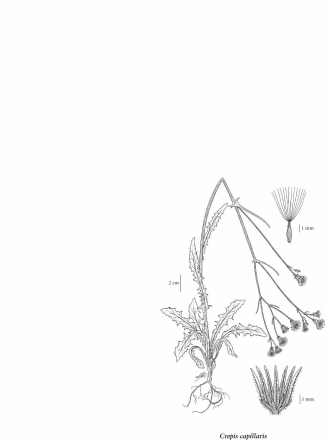Click on the image below to view an
expanded illustration for this species.

|
General:
Annual or occasionally biennial herb from a relatively short taproot; stems erect, solitary, often much branched, short-hairy near the base or throughout, 20-90 cm tall.
Leaves:
Basal leaves lanceolate or oblanceolate, 3-30 cm long, 5-45 mm wide, long- to short-stalked, toothed to pinnately cut, the lobes pointing backwards, or evenly bipinnately parted, the blade obtuse or abruptly sharp-pointed, glabrous or short-hairy beneath on the midrib with short yellow hairs, sometimes sparsely short-hairy above and often soon deciduous; lowermost stem leaves similar to the basal; middle and upper stem leaves lanceolate, abruptly sharp-pointed, unstalked, with abruptly sharp-pointed, ear-like flanges at the base.
Flowers:
Heads with strap-shaped flowers, 20-60 in a flat- or round-topped inflorescence; involucres 5-8 mm tall, cylindric to top-shaped; involucral bracts glabrous or woolly, the outer ones about 8, linear, up to 1/2 as long as the 8-16 inner ones, these woolly and often glandular-bristly with black hairs as well, glabrous within, lanceolate, abruptly sharp-pointed, becoming spongy-thickened on the back; receptacle glabrous; ray flowers yellow, 7.5-12 mm long.
Fruits:
Achenes brownish-yellow to dark brown, 1.5-2.5 mm long, spindle-shaped or oblong, abruptly narrowed at both ends, about 10-ribbed; pappus white, of fine, soft, hairlike bristles.
Source: The Illustrated Flora of British Columbia
|
